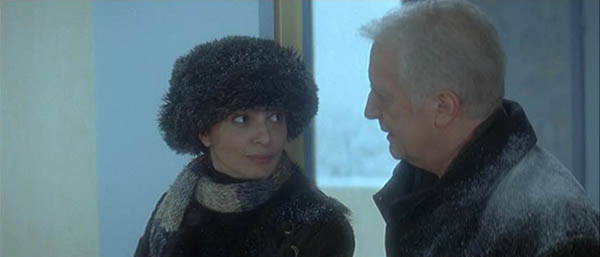All those people smiling on the cover of the DVD tricked us into expecting a romantic comedy, not these wintry intertwined tales of sad, lonely Parisians.
Relationships: Thierry and Charlotte are real-estate agents. Thierry lives with his younger sister Gaelle. Gaelle is dating men from the internet and meets Dan. Dan is breaking up with his girlfriend Nicole. Nicole is looking for a new apartment with the help of Thierry. Dan hangs out a a hotel bar tended by Lionel. And Lionel’s elderly father (offscreen Arthur) is looked after part-time by Charlotte.
Difficulties: Charlotte, very religious, secretly likes to tape herself dancing in naughty lingerie. Thierry sees one of the tapes and becomes attracted to Charlotte. Gaelle catches her brother watching the tape and gets angry. Nicole is frustrated with Thierry and can’t find an apartment. Charlotte and Lionel don’t know what to do with Lionel’s horrible father. Aaaand Gaelle sees Dan talking with Nicole and runs off.
Written by the same playwright who did Smoking/No Smoking, Private Fears etc was the original title and Resnais changed the film’s title to Coeurs. Easy enough to see why. He shoots one careful scene at a time (no cross-cutting), softly falling snow behind every window and over every scene transition, every once in a while a sudden zoom (signifying what?). Soft and incomplete boundaries between people, beginning with a bedroom split in half by a wall (so the two “rooms” share a window), then Lionel’s bar, his father in the other room with the door always open, a curtain of beads, a glass wall between the real-estate agents’ desks. Gaelle’s failure to connect with Dan helps her reconcile with her brother. Charlotte’s aching hidden desire to express herself frustrates Thierry but helps free Lionel. The actors are all super, and their characters are affecting, building up to a snowing-indoors finale.
Music by Mark Snow (X-Files!) and shot by Assayas fave Eric Gautier, who also did Gabrielle and Into the Wild.
Nicole – Laura Morante of The Son’s Room

Dan (left) – Lambert Wilson, the english guy from Not On The Lips

Charlotte РSabine Az̩ma, star of Melo, Not On The Lips, Same Old Song and Smoking

Gaëlle – Isabelle Carré of various films I’ve never heard of

Lionel – Pierre Arditi of Melo, Smoking, Same Old Song

Thierry – André Dussollier, Audrey’s lawyer? uncle? in A Very Long Engagement and in Same Old Song, Melo and Rohmer’s Perceval le Gallois

Arthur (offscreen) – Claude Rich of Stavisky
Dave Kehr:
“At first, Resnais’s mise-en-scene seems stiff and broadly theatrical, emphasizing the divisions within the decor and between the characters; then, the camera becomes more mobile, rising above walls and partitions, as the characters seem to break out of their established orbits and begin colliding with each other. The playing becomes more naturalistic, the lighting more gentle, and the geometry of the compositions less harsh as seemingly appropriate couples begin to form.” … “At 84, the eternally elegant, emotionally reserved Resnais seems to be allowing the mask to slip a bit: this is the quietly devastating testament of a deeply lonely man.”
Keith Ulrich in Slant:
“There’s more than a whiff of contempt in the way Ayckbourn conceives his seven upper-class characters, all of whom circle in and out of each others’ lives with contrived dramaturgical abandon, but Resnais’s inquiry into their tragicomic malaise is genuine, at best enraptured.”
Jonathan Rosenbaum:
“It’s an archetypal and at points almost insufferably clever piece of boulevard theater — the sort of thing Resnais has been producing periodically ever since he adapted the French play Melo in 1986 and began mining his childhood playgoing experiences. At the same time, it’s a lyrical lament that doubles as a comprehensive retrospective of his career. The characters, invested with an almost tragic tenderness, are by and large played by actors Resnais has been using for two decades. When Dan and Gaëlle trade confidences in the hotel bar, we could almost be back in Hiroshima Mon Amour (1959), just as a camera movement exploring part of a flat summons up Last Year at Marienbad (1961) and a montage of domestic objects returns us to Muriel (1963). All three of these films, to some degree, are about private fears in public places, a theme that’s come up again and again in his work.”
and
“The film’s constant snowfall, not at all indicative of typical Paris weather, is a personal invention with no counterpart in the play. (Another is the 19th-century portraits and landscape paintings, by Turner and others, that crop up in some of the flats, pointing toward the characters’ unacknowledged Victorianism.) This magical heavy snow, viewed through windows and used in transitions bridging the film’s 54 short scenes, is as laden with metaphorical nuance as the snow in Citizen Kane and The Magnificent Ambersons. It’s so central to the overall mood and visual texture that when we suddenly see it falling inside a kitchen during a climactic scene, shortly before the camera starts to encircle two characters, the moment’s emotional logic is perfectly pitched. Fundamentally, Resnais has always been an expressionist, using his settings and compositions to evoke the inner states of his characters. Here, tying expressionism to social critique, he becomes an improbable but unmistakable blood brother of Carl Dreyer, turning material written by others into a highly personal testament that burns its way into our souls.”